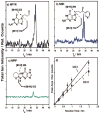Synergistic metabolic toxicity screening using microsome/DNA electrochemiluminescent arrays and nanoreactors
- PMID: 18563913
- PMCID: PMC3483639
- DOI: 10.1021/ac800763r
Synergistic metabolic toxicity screening using microsome/DNA electrochemiluminescent arrays and nanoreactors
Abstract
Platforms based on thin enzyme/DNA films were used in two-tier screening of chemicals for reactive metabolites capable of producing toxicity. Microsomes were used for the first time as sources of cytochrome (cyt) P450 enzymes in these devices. Initial rapid screening involved electrochemiluminescent (ECL) arrays featuring spots containing ruthenium poly(vinylpyridine), DNA, and rat liver microsomes or bicistronically expressed human cyt P450 2E1 (h2E1). Cyt P450 enzymes were activated via the NADPH/reductase cycle. When bioactivation of substrates in the films gives reactive metabolites, they are trapped by covalent attachment to DNA bases. The rate of increase in ECL with enzyme reaction time reflects relative DNA damage rates. "Toxic hits" uncovered by the array were studied in structural detail by using enzyme/DNA films on silica nanospheres as "nanoreactors" to provide nucleobase adducts from reactive metabolites. The utility of this synergistic approach was demonstrated by estimating relative DNA damage rates of three mutagenic N-nitroso compounds and styrene. Relative enzyme turnover rates for these compounds using ECL arrays and LC-UV-MS correlated well with TD 50 values for liver tumor formation in rats. Combining ECL array and nanoreactor/LC-MS technologies has the potential for rapid, high-throughput, cost-effective screening for reactive metabolites and provides chemical structure information that is complementary to conventional toxicity bioassays.
Figures





Similar articles
-
High-throughput metabolic genotoxicity screening with a fluidic microwell chip and electrochemiluminescence.Lab Chip. 2013 Dec 7;13(23):4554-62. doi: 10.1039/c3lc50698c. Lab Chip. 2013. PMID: 24113555 Free PMC article.
-
Differences in metabolite-mediated toxicity of tamoxifen in rodents versus humans elucidated with DNA/microsome electro-optical arrays and nanoreactors.Chem Res Toxicol. 2009 Feb;22(2):341-7. doi: 10.1021/tx8004295. Chem Res Toxicol. 2009. PMID: 19166339 Free PMC article.
-
Evaluation of electrochemiluminescent metabolic toxicity screening arrays using a multiple compound set.Anal Chem. 2011 Apr 1;83(7):2754-60. doi: 10.1021/ac200050n. Epub 2011 Mar 11. Anal Chem. 2011. PMID: 21395325 Free PMC article.
-
Metabolic toxicity screening using electrochemiluminescence arrays coupled with enzyme-DNA biocolloid reactors and liquid chromatography-mass spectrometry.Annu Rev Anal Chem (Palo Alto Calif). 2012;5(1):79-105. doi: 10.1146/annurev.anchem.111808.073659. Epub 2012 Apr 5. Annu Rev Anal Chem (Palo Alto Calif). 2012. PMID: 22482786 Free PMC article. Review.
-
Screening Genotoxicity Chemistry with Microfluidic Electrochemiluminescent Arrays.Sensors (Basel). 2017 May 3;17(5):1008. doi: 10.3390/s17051008. Sensors (Basel). 2017. PMID: 28467352 Free PMC article. Review.
Cited by
-
High-throughput metabolic genotoxicity screening with a fluidic microwell chip and electrochemiluminescence.Lab Chip. 2013 Dec 7;13(23):4554-62. doi: 10.1039/c3lc50698c. Lab Chip. 2013. PMID: 24113555 Free PMC article.
-
Rapid LC-MS drug metabolite profiling using microsomal enzyme bioreactors in a parallel processing format.Anal Chem. 2009 Dec 15;81(24):9921-9. doi: 10.1021/ac9015853. Anal Chem. 2009. PMID: 19904994 Free PMC article.
-
Differences in metabolite-mediated toxicity of tamoxifen in rodents versus humans elucidated with DNA/microsome electro-optical arrays and nanoreactors.Chem Res Toxicol. 2009 Feb;22(2):341-7. doi: 10.1021/tx8004295. Chem Res Toxicol. 2009. PMID: 19166339 Free PMC article.
-
Characterizing metabolic inhibition using electrochemical enzyme/DNA biosensors.Anal Chem. 2009 Jan 15;81(2):716-24. doi: 10.1021/ac802179s. Anal Chem. 2009. PMID: 19099359 Free PMC article.
-
Microfluidic electrochemical array for detection of reactive metabolites formed by cytochrome P450 enzymes.Anal Chem. 2011 Dec 15;83(24):9499-506. doi: 10.1021/ac202269t. Epub 2011 Nov 15. Anal Chem. 2011. PMID: 22040095 Free PMC article.
References
-
- Kola I, Landis J. Nat Rev Drug Discovery. 2004;3:711–715. - PubMed
-
- Kramer JA, Sagartz JE, Morris DL. Nat Rev Drug Discovery. 2007;6:636–649. - PubMed
- Caldwell GW, Yan YL. Curr Opin Drug Discovery Dev. 2006;9:47–50. - PubMed
- Nassar AEF, Kamel AM, Clairmont C. Drug Dev Today. 2004;9:1055–1064. - PubMed
- Rusling JF, Hvastkovs EG, Schenkman JB. Curr Opin Drug Discovery Dev. 2007;10:67–73. - PubMed
-
- Van Gompel J, Woestenborghs F, Beerens D, Mackie C, Cahill PA, Knight AW, Billinton N, Tweats DJ, Walmsley RM. Mutagenesis. 2005;20:449–454. - PubMed
- Hastwell PW, Chai LL, Roberts KJ, Webster TW, Harvey JS, Rees RW, Walmsley RM. Mutat Res. 2006;607:160–175. - PubMed
- Kirkland D, Pfuhler S, Tweats D, Aardema M, Corvi R, Darroudi F, Elhajouji A, Glatt H, Hastwell P, Hayashi M, Kasper P, Kirchner S, Lynch A, Marzin D, Maurici D, Meuiner JR, Muller L, Nohynek G, Parry J, Parry E, Thybaud V, Tice R, van Benthem J, Vanparys P, White P. Mutat Res. 2007;628:31–55. - PubMed
- Emmert B, Bunger J, Keuch K, Mueller M, Emmert S, Hallier E, Westphal GA. Toxicology. 2006;228:66–76. - PubMed
Publication types
MeSH terms
Substances
Grants and funding
LinkOut - more resources
Full Text Sources
Other Literature Sources
Molecular Biology Databases

